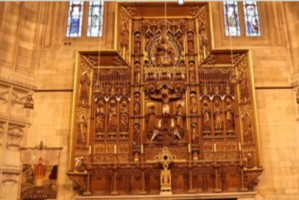
Wednesday, 14 February 2018 Talk at Jurys Inn
Who could imagine that a description of a wooden carving would keep 40 people spellbound for so long. But this was the case on Wednesday, 14 February, when
Martin Horrell told us the history of the reredos.
Martin bemoaned the fact that there were so few of these carvings in existence, so many having been destroyed during the Reformation when windows were smashed and statues and carvings
destroyed. We saw pictures of some from France and they were quite magnificent. But there are a few in England which have survived. St Cuthberts in Wells had two reredoses which
were found hidden under plaster – one has survived.
A reredos in St James Church in Somerton, Oxfordshire, was buried in the 17th century and only rediscovered in 1822. It is in remarkable condition, save for one damaged area immediately below the
figure of Christ. Presumably someone has “rubbed out” Judas Iscariot. There is also a reredos in Whimple church, carved when the church was rebuilt in the late 1800s.
Exeter’s own reredos is in St David’s Church just across the road from Exeter College and General Buller. The reredos was carved by Nathaniel Hicks, considered to be the finest Gothic carver of his
era. He was given work by many of the great architects of the day including George Gilbert Scott and his carvings are all over the country – in cathedrals and churches from Truro and Budleigh
Salterton to Bristol, Canterbury, Lincoln and Peterborough, as well as Australia, the United States and India.
The centre of Exeter’s reredos features Christ on the cross. The Anglo-Saxon word for crucifix is 'Rood' (hence the term Rood Screen) and when it is accompanied by
statues they are always St Mary on Jesus's right with St John on his left. Behind Mary’s head is carved a sun, while behind St John is a moon. These signify the beginning and the
end.
Paintings and carvings of saints always show a halo. This is a Greek word to describe a threshing floor, which is circular and immaculately clean. Jesus’s halo has a cross on it, saints
have a gold disc, a triangular halo denotes the Trinity, while a square one is for saintly people not yet recognised as saints.
The reredos also features saints, and particularly the apostles, and we learnt about their lives, and sadly their deaths - which were anything but peaceful. Martin explained that for a largely
illiterate community, it was necessary to identify statues by other than writing their names. So most of them feature personal attributes to enable people to know who they are
admiring. Sadly it is the method of their dying which is often the featured attribute.
For instance, St Laurence was placed on a grid iron over flames so he is featured with a grid iron while St Mathias was stoned nearly to death and then beheaded. His attribute is therefore an
axe. “Doubting” Thomas died in India having been stabbed with a spear. He is depicted with a spear.
Poor St Bartholomew was flayed alive and then executed, probably in Armenia. So his statues show him holding the knife with which he was flayed. St Peter is shown with a bunch of
keys signifying that he is in charge of the Gates of Heaven—at last a happy attribute.
St John the Evangelist is usually depicted holding a chalice containing either a dragon or a snake. This is because, to “test” his honesty, the High Priest insisted he should drink
poison. Two condemned men, who also partook of the poison, died but John survived and then brought the condemned back to life again. The dragon or snake signify that the chalice contains
poison.
St Andrew, the Patron Saint of Scotland, was executed on a saltire, an x-shaped cross. So he is always depicted with two narrow planks. Saint Simon the Zealot was executed by being
suspended upside down and sawn in half, which is why he is always shown holding a saw, while St James the Lessor was pushed off a wall for preaching and then beaten to death by a man with a
club. So he is always shown holding a club.
The list of horrors was almost too much to bear. But the carvings were so beautiful and to have them explained to us in such detail ensures that we will all be making an early trip to St
David’s to see for ourselves and admire the exquisite work.

